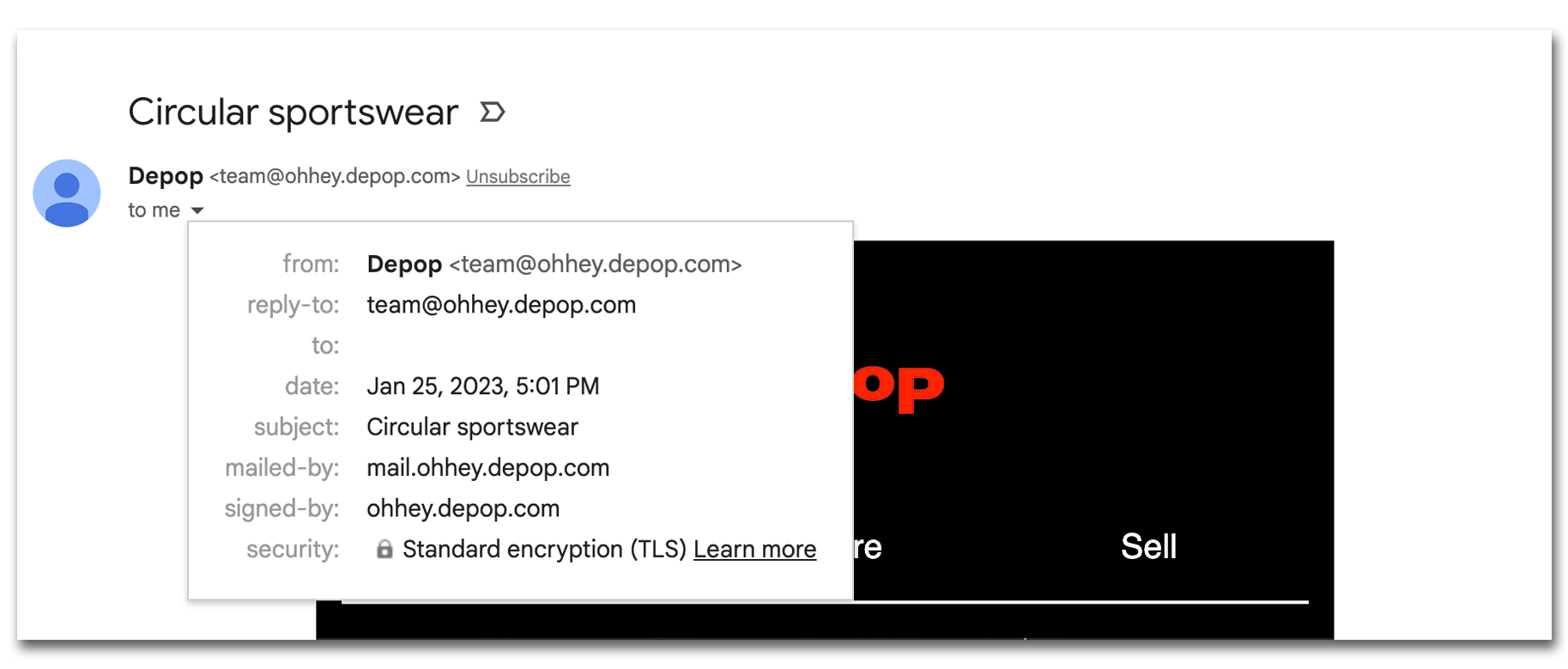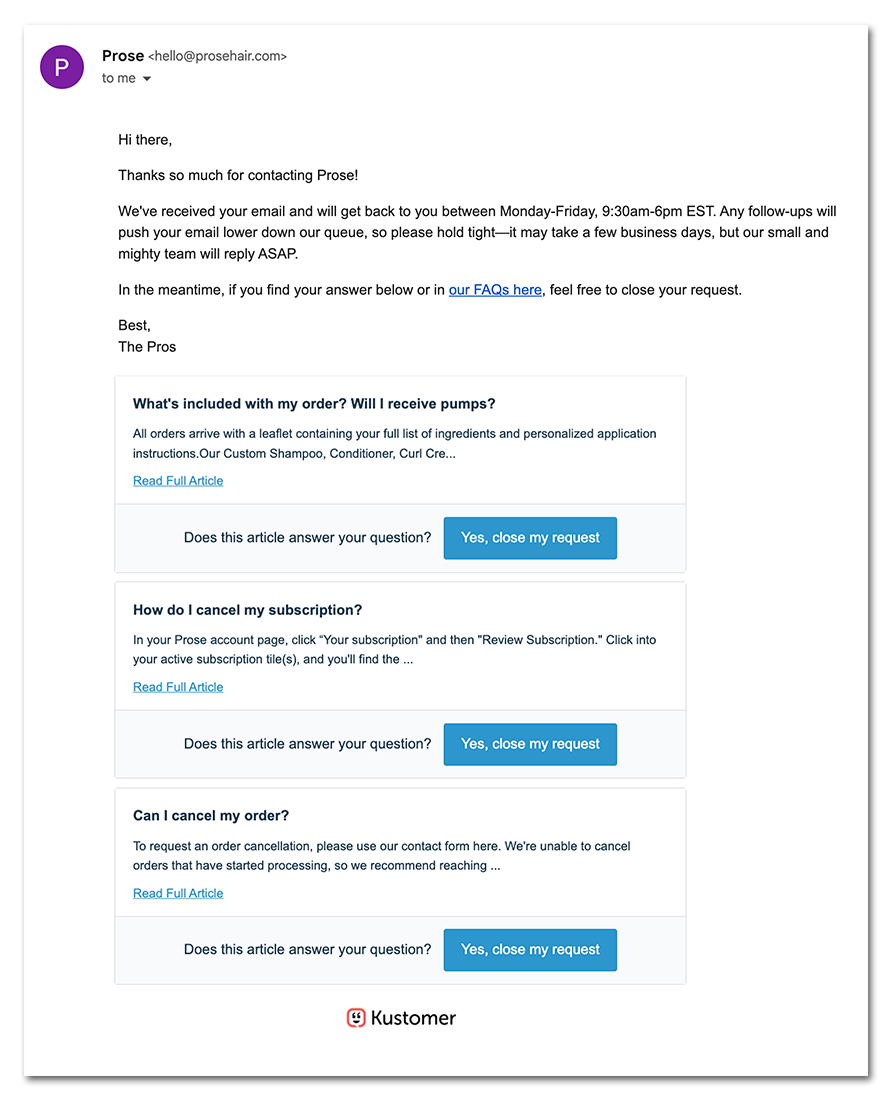Say “No” to No-Reply Email Addresses (And What to Do Instead)
Your subject line, preview text, and sender name (aka, the “envelope”) are key to getting your subscribers to open your email. But what about after they open—and have something to say?
Sometimes overlooked, the reply-to email address and from name are key identifiers for your subscribers—especially if they choose to reply to an email (which many do!). From a customer support perspective, these are important parts of your email that should never be overlooked.
In this post, we guide you through everything you need to know about reply-to email addresses—including what they are, why they’re important, and how to handle responses.
| Table of contents |
To help paint a fuller picture, we asked our own Customer Support Senior Manager Nicole Swift (she/her) to share insight on how teams can best approach incoming responses from a customer support perspective.
What is the reply-to email address field?
Within your ESP (email service provider), there are several fields that you can define for your email header. The from name and email address let the subscriber know who the email was sent from, as the name suggests. The from email address can be set by you via your ESP, or your ESP may choose something on your behalf, depending on how your account is set up with them. However, the from email address isn’t always where you want your email replies to go to.
For example, you may want to have a consistent from email address for your transactional and marketing emails for deliverability reasons (as frequent changes to your from email address could reset your sender reputation). But you might want the replies for each type of email you’re sending (transactional vs. marketing) to be sent to specific mailboxes, tied to the type of email the customer is replying to.
That’s where the reply-to email address and name come in. These two fields will appear if a subscriber hits reply to an email you’ve sent to them.
Depending on the ISP (inbox service provider), subscribers can sometimes see the reply-to email address by viewing more details of the email they’ve seen:

In the example above, the reply sent by the subscriber will then, as expected, go to that reply-to email address.
The importance of the reply-to email address and name
Just as the from name and email address are customer-facing fields, so are the reply-to email address and name. Subscribers can see both of these fields when they hit reply, so you’ll want to make them as on-brand and customer friendly as possible.
By responding to subscribers (vs. using a no-reply address and not responding) you help:
- Set a foundation of trust with subscribers and customers that you can then build from
- Create a valuable feedback loop whether an issue (like a broken email) or positive feedback
- Humanize your brand by showing subscribers that there’s real people behind your emails
1. Set a foundation of trust
“Showing subscribers that there are real people behind your emails sets a foundation of trust, where it’s easy for them to get to the support team and get help, because they’ve already established there’s an actual person on the other side,” says Swift. In short, you reap the benefits just by being a voice on the other end.
2. Create a valuable feedback loop
Not only does humanizing your brand help establish trust, it creates a two-way street where subscribers can give you valuable feedback, too!
Swift shares, “It gives customers an outlet to share feedback that you can also take to the team (for example, if there’s been an actual issue with the email). It can help with remedying an issue really fast.
3. Humanize your brand
Don’t expect all replies to be negative, either! “It can even be a kudos that makes your internal team feel good,” shares Swift.
At Litmus, we have a vocal audience of subscribers who will reach out, just to give a compliment. “Even if it’s a simple ‘Hey! That’s a funny email!’ it will end up reaching the team that worked on that email.”
By letting your subscribers know that their feedback was received, it makes them a little more invested in your brand. (You can even take the positive feedback to help inform your email content strategy, too!)
Let’s take a look at some of the drawbacks of using a no-reply email address.
The problem with a no-reply email address
You might be wondering, “Can’t I just set up a no-reply email address?” There’s a train of thought that goes, if you explicitly use “no-reply” or “no reply” in your reply-to email address and name, it should be an indication that no one will reply. However, just because you think you’ve explicitly laid something down to the subscriber, doesn’t mean they’ll see it and understand it that way.
It’s not uncommon to see reply-to email addresses with no-reply in the name—for example, “noreply@companyname.com.” Why? To dissuade customers from replying to marketing emails. Often these mailboxes are unmanned, perhaps due to lack of resources—there’s no one available to reply to the emails that make it to that inbox.
Additionally, if you’re sending email to hundreds, thousands, or even millions of people, you may get a lot of replies—including OOO (out of office) autoresponders. These can pile up in an inbox, and when they do are a pain to manage.
That’s why, many brands will choose to make their jobs a little easier by simply not bothering with these messages. However, this can be damaging brands, as it hurts potential and current customers who actually want (or need) to get in touch, because they have a real question, want to make a purchase, or want to provide feedback.
The negative impacts of no-reply email addresses
Put yourself in the subscribers shoes. You’ve just opened an email and there’s something in that’s willing you to reply—whether it’s a bug you noticed or a nice shoutout. So you hit reply—it’s fast, easy, and requires one click. However, after your take the time to write and send the email, you don’t register that you’re replying to a no-reply email address. Days go by and… no response. Not only is that a poor subscriber experience—it’s a poor customer experience, too.
Email shouldn’t be a one way street—it’s there to engage with your subscribers. Your messages, including the reply-to, should encourage customers to get back to you with valuable feedback. So instead of discouraging people from replying, think about ways to help handle responses from customers who are getting back to you.
Alternatives to using no-reply in your reply-to email address
Given that “no-reply” can look fairly negative to the customer, using something like “hello@” (like Our Place does below) is a touch friendlier. Paired with a recognizable from name, it’s a much more positive envelope for your customers to see if they choose to reply.

Here are some common examples we saw in our inbox of reply-to addresses:
- info@companyname.com
- team@companyname.com
- support@companyname.com
- messages@companyname.com
- help@companyname.com
You can use something more specific to your brand too, like The New York Times does here.

How to handle replies (even if you’re on a small team)
In a perfect world, the best approach would be to reply to each response individually, and have a dedicated resource setup to facilitate this process. And while using a more welcoming reply-to email address can make it more likely for subscribers to reply to your emails, it can be intimidating to think of the volume of responses you’ll receive.
Ask yourself if you have the resources to handle replies from your marketing messages. Resources could mean people, tools, and even budget.
So, how do you prepare for this? One solution: an autoresponder.
How to set up an autoresponder
There’s nothing worse than sending an email and waiting for a reply that never comes.
One of the best ways to handle email replies from subscribers would be to set up an autoresponder email—an email that gets automatically sent to anyone who replies to your emails.
The content of the autoresponder email will depend on how you want to handle replies from subscribers. You can approach this in a few ways:
- Option 1: Dedicated mailbox
- Option 2: Give the subscriber an alternative
Option 1: Dedicated mailbox
If you have the resources, a dedicated and manned mailbox for subscriber replies is the ideal solution. Managed and triaged by the customer services department, any replies that are received can be addressed efficiently.
With this solution, your autoresponder should be in place for immediate responses to any replies. Make sure to:
- Give the subscriber a heads-up that their message has been received, as timely as possible.
- Let them know someone will get back to them within a certain amount of time.
- Remember not to overpromise on the time frame.
- Be realistic.
You can also include helpful information, like FAQs or help articles.
Example of an autoresponder with a dedicated mailbox: Prose
DTC haircare brand Prose is friendly and transparent with their autoresponder. An autoresponder email was triggered immediately after the customer reached out with an inquiry. In the email, they thank the subscriber for reaching out, and include key pieces of information:
- Hours of operation: Monday-Friday, 9:30am-6pm EST
- Insight on their process: “Any follow-ups will push your email lower down our queue, so please hold tight”
- Transparency: “It may take a few business days”
- A touch of personality: “Our small and mighty team will reply ASAP”
- Helpful links: They include a link to the their FAQs as well as include them in the email directly

Option 2: Give the subscriber an alternative
Even if you lack the resources for a dedicated mailbox to handle subscriber replies, you should still set up an autoresponder that offers an alternative.
“Not everyone can be monitoring an inbox and responding to it messages. But it’s still an opportunity to show that you’re human, and that there’s people behind your brand,” explains Swift.
It doesn’t have to be complicated, either! Simply let them know that no replies are received from that mailbox. Ensure to:
- Populate your autoresponder with a message that indicates the mailbox is not monitored.
- Within the email, point the subscriber to an alternative email address, phone number, or contact page that is actively monitored.
How to handle OOO replies
Unfortunately, many customer service teams have to sift through a lot of OOO replies. It’s an accepted part of having a real reply-to email address, where OOO replies do occur. Receiving OOO replies can be fairly common if your organization is a B2B company, where many of the subscribers will use their work emails.
The good news is that many ESPs can be set up to handle OOO replies, which are sent to your reply-to email address. You will need to check with your ESP on how those rules and filters can be set up. Correctly setting up rules and filters with your ESP will ensure that the OOO reply isn’t rejected and sent back to the customer as “undeliverable” (which is something you want to avoid as it doesn’t give the customer a good impression of you as a trusted sender).
How Litmus handles incoming responses
Here at Litmus, all of our email replies go to our customer support mailbox (aka, Swift’s team!) where the messages—whether they’re comments, feedback, or questions—are responded to individually by members of the customer support team, or triaged to the appropriate person.

“Support and marketing work really closely here,” shares Swift. “I think it’s a great model for other companies to have as well, because we’re both talking to the customers.
Marketing is a one-to-many approach while customer support is one-to-one. But that doesn’t mean the two should work in silos. “You need both to work together because it creates a feedback loop to help each other improve.”
There’s incredible value in what customers tell your support team. “One person can give us information that can be useful for reaching many (in which case we share with the marketing team). And the messages/resources meant for many can also encourage individual conversations, where we can grow our relationships,” says Swift.
Communication is a two-way street
Alongside the from name and email address, the reply-to email address and name are key pieces of information in your email “envelope” that help your subscribers identify you as a trusted sender.
Remember, email is a form of communication between you and your subscribers. Your subscribers may see it the same way—as a direct pipeline back to you, the sender. Keep that pipeline open. Choose a customer friendly reply-to email address and name and put your process in place for dealing with replies from your subscribers.
Consider running an A/B test of what combination of your from name and reply-to email address works best for your email program.
Originally published on September 7, 2016, by Jaina Mistry. Last updated February 2, 2023.

Kimberly Huang
Kimberly Huang is a Content Marketing Manager at Litmus


